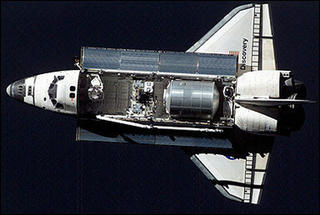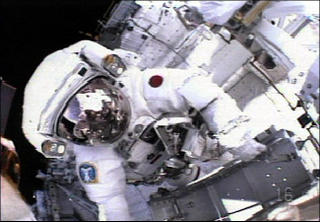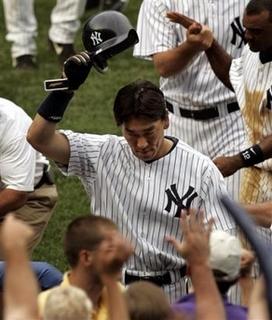This NYTimes article came in from the RSS Feeder.

Last Tuesday morning, NASA's contention that it had produced the safest fuel tank in shuttle history was shattered two minutes into the Discovery's mission to the International Space Station. Two spacewalking astronauts tested repair techniques at the station yesterday.
The 0.9-pound piece of foam that fell from the PAL ramp on liftoff, which could have led to another catastrophe if it had ripped away a minute sooner, forced the immediate suspension of future shuttle flights until the problem could be resolved.
How did it happen? In hindsight, it is clear that the effort to resolve the PAL ramp problem was a chain of missed opportunities and questionable judgments, not just since the Columbia disaster but over the life of the shuttle program.
Potentially useful tests were not performed. Innovative solutions were not seriously pursued. Tantalizing clues were missed. In the end, the old engineering maxim "If it ain't broke, don't fix it" trumped vague misgivings about a part that had not shed any foam, as far as anyone knew, since 1983.
"After two and a half years, they should have been able to fix the foam," said Paul A. Czysz, a professor emeritus of aeronautical engineering at St. Louis University and a veteran consultant to NASA.
Well, that last statement seems rather open to debate. There's nothing to suggest that if they couldn't solve it in the 80s and 90s, that there has been a fundamental technologoical breakthrough that allowed them to solve it in the last 2 and a half years.
Anyway, the NYT article goes on to say:
At the dawn of the shuttle program, NASA rules said no foam at all should be allowed to hit the shuttle and possibly damage the fragile heat-resistant tiles that cover its aluminum skin.We of course know what happened after that in the CAIB report. Then here's this little bit:
But fidelity to those standards was relaxed over time; in fact, foam fell from a PAL ramp in two early missions, including the one in June 1983 on which Sally Ride became the first American woman in space. There may have been many more incidents, but dozens of shuttle missions have been launched in darkness, with no visual record of foam, and the tanks themselves cannot be retrieved from the ocean for analysis.
As the early tank was replaced with two lighter successors, the PAL ramps remained - one a 19-foot baffle along a channel for cables and pressurized lines along the forward end of the tank and the other the 37-foot strip along the flank of the cylindrical midsection of the fuel tank. And as experience showed NASA that shuttles returned safely despite well over 100 nicks and gouges requiring repair on many flights, the concerns abated over time.
Until Feb. 1, 2003, the day the Columbia disintegrated on its way home to Cape Canaveral.
---
After the accident, NASA examined all possible sources of liftoff debris, eventually identifying more than 170. Engineers recognized that they could not eliminate all risk from debris, but they could do a much better job of reducing it.
For many aeronautical engineers, a central rule in developing an aircraft is taking its components beyond the breaking point.So they went with the devil they knew. Now they have to reconsider that bargain.Yet, there's still this problem:
"If you don't break a wing, you just have assumptions about what might make it break," said Aldo J. Bordano, a retired NASA aerosciences chief who was on a panel that studied the agency's analysis of the external tank and foam.
He said that while it was premature to conclude whether mistakes were made, many panel members were frustrated with the lack of physical testing of the foam under liftoff conditions.
In any event, NASA decided that the tank without the ramp would expose the cables and hoses to destructive winds; agency engineers and managers considered alternatives but could not come up with any that inspired confidence.
"The community was very diligent about looking at this," Mr. Parsons said in announcing the PAL ramp problem last week. "We did realize that eventually one day we needed to put together a program to remove this PAL ramp if at all possible. But at the time, we didn't have enough data where we could technically do that and be safe."
A NASA engineer who works on tank safety issues said other areas of foam shedding from the Discovery's tank were even more troubling than the PAL ramp loss, especially a divot that popped from the vicinity of the left-hand bipod strut, the spot that shed the foam that brought down the Columbia.It makes one groan with frustration when one reads somebody is scared to speak up because it might jeopardise his career, when 7 astronauts are going up in the craft with the same infrastructure flaws as the ones that burnt up Columbia. So much for the great cause of accountability.
"We worked the hell out of that," said the engineer, who was given anonymity because he said disclosure of his name would jeopardize his career. The loss of foam from that spot after so much work to correct the problem, he went on, proves that the problem is still far more complex than NASA understands.
So the space agency is back to the drawing board. Some of the options under consideration have come up before, including the elimination of the ramp, a "miniramp" that shrinks the size of the strip by two-thirds, and a small "fence" on the opposite side of the tray that would smooth airflow further. Another possibility, rotating the tank so the ramp faces away from the shuttle, would take years, engineers say.
 The above is Dr. Soichi Noguchi of Japan, doing it hard in EVA.
The above is Dr. Soichi Noguchi of Japan, doing it hard in EVA. Discovery looks like it's going to spend an extra day on its schedule.
The extra day in orbit will allow the crew to get a head start on tasks that could be affected by the suspension of those flights: removal of trash and old equipment from the space station.So they get the Japanese guy to take out the garbage. That'd be right. :)
Some 11 tonnes of waste have piled up over three years, cramping residents on the space station.
Astronauts will pack it into the Rafaello transport module, which the seven shuttle crew members and two space station residents began on Friday to unload of 13.5 tonnes of food and equipment.
Rafaello is an Italian-built pressurized transport module that rides in Discovery's cargo bay and was lifted to the space station with the help of the shuttle's Canadian-built robot arm.
The spacewalk formally began at 4:46 am (0946 GMT), an hour later than scheduled, NASA said, as Discovery remained moored to the space station.
After depressurizing an airlock between the shuttle and its open cargo bay, Japanese astronaut Soichi Noguchi and American Steve Robinson switched to the batteries of their spacesuits, a procedure that, NASA says, formally marks the beginning of a spacewalk.
They then opened a massive hatch and began making their way into the shuttle's cargo bay to start six and a half hours of work.
The spacewalk, the first of three, included testing new ceramic tile repair methods and work on the ISS.
At least he gets to go to space. Now, to see if he can come back home alive...
Yankees Scratch Out A Win
 It was close and down to the bottom of the ninth . The Yankees got out of jail with Hideki Matsui hitting a game-winning double off K-Rod's 36th pitch. You gotta like that kind of fight. At least you don't see the Yankees sending him out to take out the garbage. Still, the Yankees are 2.5 games behind now after a couple of tough losses.
It was close and down to the bottom of the ninth . The Yankees got out of jail with Hideki Matsui hitting a game-winning double off K-Rod's 36th pitch. You gotta like that kind of fight. At least you don't see the Yankees sending him out to take out the garbage. Still, the Yankees are 2.5 games behind now after a couple of tough losses.Meanwhile there are rumours coming out of Boston of a Manny Ramirez for Mike Cameron trade .
Ramirez was removed just before Boston's game against Minnesota. The Red Sox said they had no trade to announce and an official involved in the talks said Saturday evening that the sides were still far apart in the much-discussed, three-team trade involving the Red Sox, Mets and Tampa Bay Devil Rays.It sounds unlikely, but you never know. Boston might manage to move Manny Ramirez and his gargantuan contract that was a sort of parting gift from the previous ownership and GM. As onerous contracts go, it's been a very productive one. Except there are strong rumours that the man has asked to be traded for the fourth time in 3 seasons, so it is possible Manny just wants out from Boston, even if he ended up with the Devi Rays - Though that's about as likely as Boston winning a World Series. Oh wait... :)
After saying he didn't want to talk about the deal, Cameron volunteered that he didn't sleep much Friday night because he'd gotten "calls all day and night long" -- and that he didn't like being the subject of rumors.
"I can't even take it," he said. "I thought I can handle it. I can't."

No comments:
Post a Comment